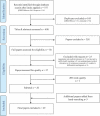Medical educators' perspectives on the barriers and enablers of teaching public health in the undergraduate medical schools: a systematic review
- PMID: 36063404
- PMCID: PMC9467537
- DOI: 10.1080/16549716.2022.2106052
Medical educators' perspectives on the barriers and enablers of teaching public health in the undergraduate medical schools: a systematic review
Abstract
Background: Having relevant public health content in the undergraduate medical curriculum is critical to preparing medical doctors for emerging health issues and increased public health roles. Medical educators are central to this effort.
Objective: This systematic review synthesises the most relevant and up-to-date evidence on medical educators' perspectives regarding the barriers and enablers on incorporating public health teaching in the undergraduate medical curricula.
Methods: Seven databases were searched for articles published between 1 January 2010 and 31 December 2021. Articles were included if they were available in full-text English or Indonesian language, peer-reviewed, and focused on medical educators' perspectives on teaching public health in the undergraduate medical curricula. Findings were integrated to answer the review question using thematic analysis.
Results: Twenty-nine articles were included in the final review. Three major themes emerged: (i) space in the medical curricula, (ii) confidence/capabilities of medical educators, and (iii) institutional support. Overcrowded curricula, lack of consensus about the scope and level of public health to incorporate into teaching, ensuring the quality and the relevance of content with what is required in real practice, as well as inadequate institutional support are major challenges in teaching public health to medical students.
Conclusions: Integrating public health into other subjects is largely seen as a solution. This requires strong institutional support in the form of financial, logistic, and technical support; structured training for medical educators on how to incorporate the content into their subjects; and a recognition of the important role that public health educators play.
Keywords: Medical curricula; medical education; medical educator; public health; undergraduate medical schools.
Conflict of interest statement
No potential conflict of interest was reported by the author(s).
Figures
Similar articles
-
A rapid and systematic review of the clinical effectiveness and cost-effectiveness of topotecan for ovarian cancer.Health Technol Assess. 2001;5(28):1-110. doi: 10.3310/hta5280. Health Technol Assess. 2001. PMID: 11701100
-
Measures implemented in the school setting to contain the COVID-19 pandemic.Cochrane Database Syst Rev. 2022 Jan 17;1(1):CD015029. doi: 10.1002/14651858.CD015029. Cochrane Database Syst Rev. 2022. Update in: Cochrane Database Syst Rev. 2024 May 2;5:CD015029. doi: 10.1002/14651858.CD015029.pub2. PMID: 35037252 Free PMC article. Updated.
-
Factors influencing the integration of comprehensive sexuality education into educational systems in low- and middle-income countries: a systematic review.Reprod Health. 2022 Sep 29;19(1):196. doi: 10.1186/s12978-022-01504-9. Reprod Health. 2022. PMID: 36175901 Free PMC article.
-
Factors that influence parents' and informal caregivers' views and practices regarding routine childhood vaccination: a qualitative evidence synthesis.Cochrane Database Syst Rev. 2021 Oct 27;10(10):CD013265. doi: 10.1002/14651858.CD013265.pub2. Cochrane Database Syst Rev. 2021. PMID: 34706066 Free PMC article.
-
School-based programmes for preventing smoking.Cochrane Database Syst Rev. 2006 Jul 19;(3):CD001293. doi: 10.1002/14651858.CD001293.pub2. Cochrane Database Syst Rev. 2006. Update in: Cochrane Database Syst Rev. 2013 Apr 30;(4):CD001293. doi: 10.1002/14651858.CD001293.pub3. PMID: 16855966 Updated.
Cited by
-
Application of artificial intelligence to the public health education.Front Public Health. 2023 Jan 10;10:1087174. doi: 10.3389/fpubh.2022.1087174. eCollection 2022. Front Public Health. 2023. PMID: 36703852 Free PMC article. Review.
-
Neurology Undergraduate Medical Education: A Scoping Review.Eur J Neurol. 2025 Mar;32(3):e70061. doi: 10.1111/ene.70061. Eur J Neurol. 2025. PMID: 40079369 Free PMC article.
-
The effect of training medical students in the community area in the midst of the Covid-19 pandemic in China: a community-based study.BMC Med Educ. 2023 Jul 18;23(1):517. doi: 10.1186/s12909-023-04509-5. BMC Med Educ. 2023. PMID: 37464393 Free PMC article.
-
Learning about Inclusion Health in undergraduate medical education: a scoping review.BMJ Open. 2025 Apr 30;15(4):e092420. doi: 10.1136/bmjopen-2024-092420. BMJ Open. 2025. PMID: 40306984 Free PMC article.
-
Enhancing Reflective Practice Using Prompts in Online Submission of Case Reports (OSCAR): An Exploratory Study Among Medical Students in Rural Longitudinal Integrated Clerkships.Perspect Med Educ. 2024 Dec 26;13(1):654-665. doi: 10.5334/pme.1416. eCollection 2024. Perspect Med Educ. 2024. PMID: 39735825 Free PMC article.
References
-
- Gillam S, Maudsley G.. Public health education for medical students: a guide for medical schools. Cambridge: Department of Public Health and Primary Care, University of Cambridge; 2008.
-
- WHO . Teaching of public health in medical schools. New Delhi: WHO; 2010.
-
- WHO. Training . Modules for teaching of public health in medical schools in South-East Asia region. New Delhi: World Health Organization; 2015.
-
- Schneider MJ. Prolog: public health in the news. Introduction to public health. Burlington MA: Jones & Bartlett Learning; 2020.
Publication types
MeSH terms
LinkOut - more resources
Full Text Sources

